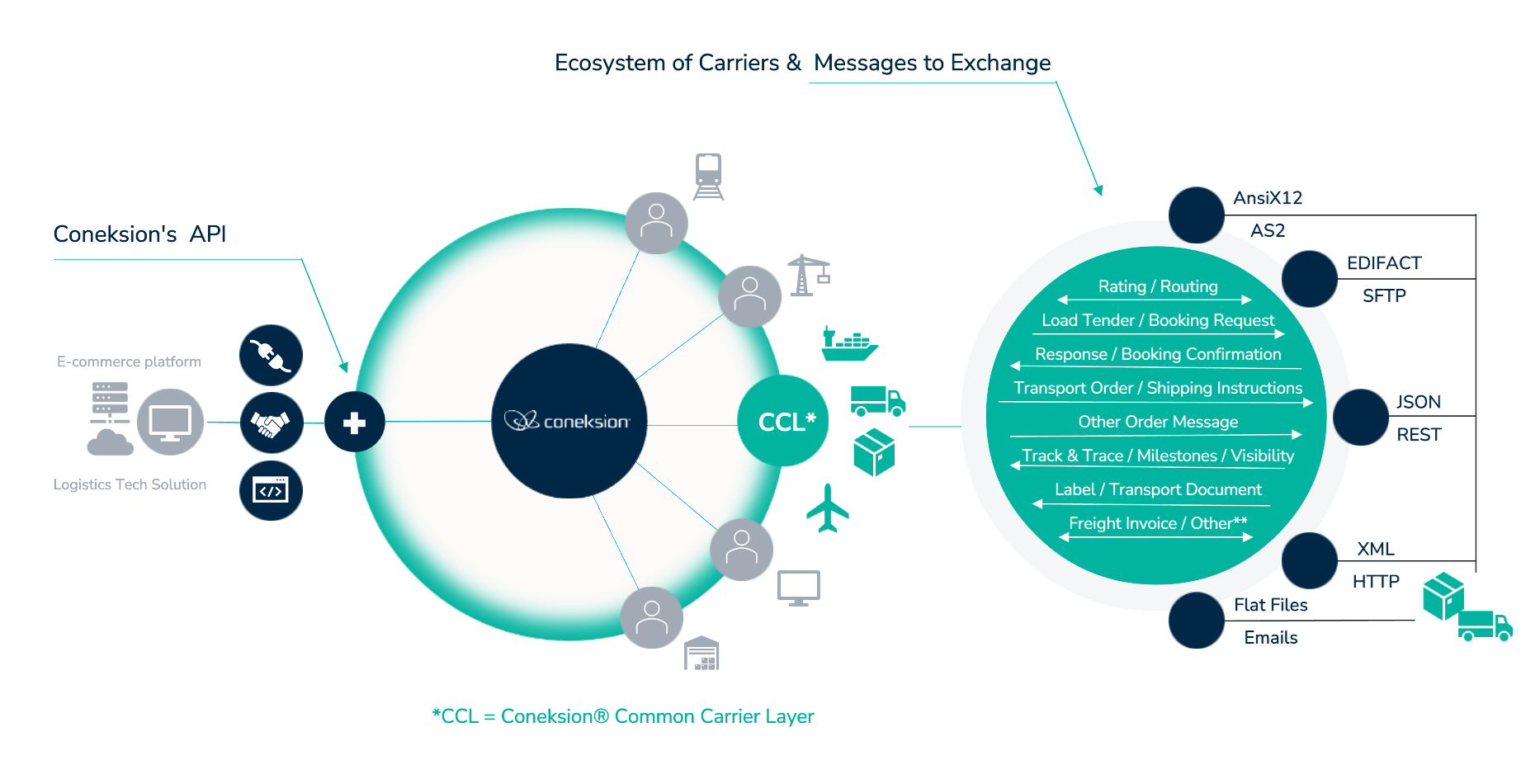Every day, millions of customers on platforms such as AliExpress, Temu, Amazon, and SHEIN place their orders, expecting them to be confirmed in seconds, tracked in real-time, and delivered on time. Meeting those expectations requires linking a platform or TMS (transportation management system) to many parties — especially local last-mile carriers that each use different systems and rules — which traditionally meant building bespoke one-to-one integrations. That approach works for a few partners but becomes unmanageable at scale as carriers use different protocols (HTTP/JSON, XML, EDI, SOAP, SFTP, or home-grown APIs), different label generation processes, and message formats. The result: slower carrier onboarding, inconsistent tracking, more failed deliveries, and higher support and maintenance costs for high-volume e-commerce businesses.
That’s where Coneksion steps in. Instead of pushing teams to build and maintain dozens of direct carrier integrations, Coneksion offers a single API point and a harmonizing connectivity layer that talks to carriers on one side and e-commerce platforms or TMS/ERP providers on the other. The effect is immediate and tangible: an e-commerce platform can connect once and gain instant access to an ecosystem of carriers, or a TMS provider can embed Coneksion’s connectivity into its product and offer carrier access to all its customers.
Coneksion® RAPIDS Road and Parcel Data Connectivity solution architecture
Two common use cases where the Coneksion solution is a game-changer
USE CASE 1: GLOBAL E-COMMERCE RETAILERS & PLATFORMS
A global e-commerce platform wants consistent, real-time shipment execution and visibility across multiple countries. They connect to Coneksion’s API and keep using the data model, technology, and standards they already rely on. They send a transport order (booking request and/or other shipping information) and receive a unified confirmation, labels, and a stream of events that show the parcel’s stage in its journey. Behind the scenes, Coneksion maps that data to the carrier’s required format, supplies the information needed for label generation, and monitors carrier milestone events — pickup, hub arrival, out-for-delivery, delivery (with POD) — while flagging exceptions or other issues. Because Coneksion’s solution is carrier-neutral and technology-agnostic, it supports multiple data-exchange methods (real-time webhooks, batch files, SFTP/EDI), so when a carrier lacks real-time APIs, Coneksion can still provide consistent visibility via polling or file ingestion. If a carrier isn’t yet in Coneksion’s ecosystem, the platform can request onboarding, and Coneksion typically adds that carrier and goes live within a week. There’s no separate engineering project per carrier, no last-minute label fixes, and no need for the e-commerce team to maintain dozens of different schemas. The result is faster time-to-market for new services, fewer failed deliveries, consistent customer notifications, and a much lighter operational burden for the platform team.
Use case 2: TMS/ERP or LogTech solution providers
A TMS/ERP or LogTech solution provider whose product powers multiple e-commerce merchants wants to expand its connectivity scope/ ecosystem without rebuilding carrier integrations for every customer. By embedding Coneksion’s API into their offering, the TMS becomes a distribution point/ a portal giving each merchant direct access to a vast network of carriers through the TMS UI or API, while Coneksion manages format harmonization, ensuring a reliable exchange of events, generated labels, and invoices. The TMS expands its ecosystem of carriers, but offloads the messy, ongoing work of building and maintaining carrier integrations. For the TMS, that translates into a faster sales cycle (they can promise carrier access sooner), less technical debt, and a stronger product positioned around operational reliability.
Scope and benefits
Across both cases, the message cycle stays the same: transport order → sometimes carrier confirmation → label response → pickup/manifest → transit visibility (scans) → delivery/exception → invoice and acknowledgement. What changes is who accesses Coneksion’s API - the ecommerce platform or a logtech solution. In either way, coneksion ensures a flow of data between its customers and carriers.
The business benefits are straightforward. Faster carrier onboarding enables a platform to expand delivery options in new locations worldwide rapidly. Better visibility means customer support teams field fewer “where is my order?” calls. Automated invoice reconciliation reduces disputes and days-to-pay. And because Coneksion adapts to the formats the merchant or TMS already uses, there’s no need to change upstream data models — minimizing interruptions to existing operations.
In a market where customers judge a company by the delivery experience, removing integration friction is a competitive advantage. Coneksion’s “one API to many carriers connectivity” approach provides e-commerce platforms and technology vendors with immediate access to an ecosystem of carriers, rapid onboarding for new carriers (often within a week), consistent, real-time visibility, and lower costs and risks for engineering and operations.
Whether you’re an e-commerce platform or a logistics-tech provider, think of Coneksion not merely as an integration vendor but as a data-integration partner that lets you focus on developing your platform — while ensuring delivery data streams are reliable, harmonized, and fast.
Want to learn more? Book a call with our team today.



